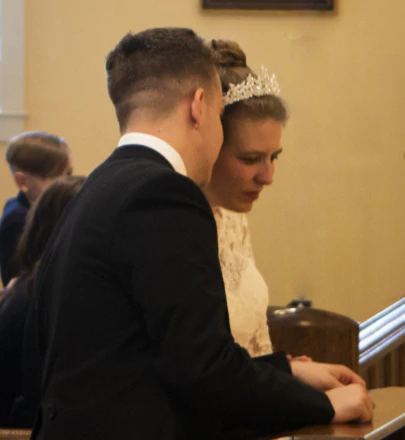FAQs

Sancta Missa also has a Latin Mass wedding Q&A1.
I want a TLM wedding! What do I do?
Great! The most important thing you’ll need is a priest familiar with the TLM wedding, or willing to learn it. Contact said priest, and the church in which you intend to marry. Availability of priests who can say the TLM (and receptivity to saying it at all) will vary by diocese. Contact the church music director as well. Start a conversation about music for your mass, as you will not (or at least, should not) be following the “4 hymn sandwich.”2
If you are brand new to Latin Masses, browse online Latin Mass directories to see the churches in your area that may offer Latin Masses.3
Check out Catholic websites like New Liturgical Movement, Musica Sacra, or Fr. Z, to find answers to more specific questions on Latin Masses and Catholic weddings.4
What’s different with a Latin Mass wedding?
Lots! The big things that are different are the language, and the order of events.
While there will be some vernacular during the Rite of Marriage, most of the ceremonies are in Latin, the official language of the Catholic Church.
In Catholic weddings in the Novus Ordo Mass, the Rite of Marriage happens in the middle of the Mass. In the Latin Mass, the Rite of Marriage happens at the beginning, and is followed by the Mass, uninterrupted.
The blog TraditionalCatholicPriest offers a comparison of the Latin Mass wedding with the Novus Ordo wedding.5
For more information on details about what makes the Latin Mass distinct, visit the Latin Mass page.
What can I customize with the wedding Mass?
Not much, really. The propers for the wedding Mass (texts of the Mass that change each Sunday, like the readings) are set and cannot be personalized. If you want a sung Mass, you can choose some of the music, to an extent, and how the music is sung (like chant or polyphony). This will depend entirely on the resources available to you and your church.
Low Mass = nothing is sung; 1 priest
High Mass = sung; 1 priest
Solemn High Mass = sung; 3 priests (priest, deacon, and subdeacon)
Be aware of the liturgical season when choosing your Mass. Traditionally penitential times or “closed times” (tempus clausum) like Lent discourage weddings and sung Masses. Again, this will vary, as resources and general catechesis varies by diocese. Dispensations can be requested, but it is not a bad idea to avoid scheduling such a festive occasion in a penitential time like Lent.6
You will not choose lectors, as the priest(s) will recite or chant the readings. You will likely not choose altar servers, as they will have to be familiar with the Latin Mass.
You can, of course, customize non-liturgical elements of the day, like flowers. Read more about floral traditions on the Flowers page.
What about music?
Visit the Mass Music page for more information!
Generally speaking, the best music setting for the mass is Gregorian chant, and the best texts are the propers (because they are directly from Scripture). Strictly speaking, hymns are private meditations and belong to the Divine Office or other private prayer time. Hymns are usually allowed for the procession in, and procession out, but otherwise they should either not be used at all in the Mass, or chosen very carefully for their beauty, timelessness, and faithfulness to the Word of God.
You may be able to choose the settings for the mass texts (how they are sung). For example, you can have the Ordinary (Kyrie, Gloria, etc.) sung to Gregorian chant, or to a psalm tone, or to a polyphonic setting.
Realistically, this will depend on the resources available to you. Be in touch with your church’s music director to see what is feasible and encouraged.
You’re using words that I don’t know.
Visit the Glossary page!
How can I help my wedding guests understand what’s happening?
You can post information on your wedding website, include commentary in your wedding program, or download/purchase Latin Mass booklets. Biretta Books used to publish a white booklet specifically for the traditional wedding Mass. It does not appear to be in print, but you may be able to find it used.
You are free to reuse my wedding program content or template - just contact me!
What if I want to learn more about the history of all of this?
Try the History page. Below is my “starter pack” on the history of Catholic marriage - both the Rite and the Mass.
Fish Eaters. “Holy Matrimony.” Accessed June 3, 2019. https://www.fisheaters.com/holymatrimony.html.
Searle, M., and K.W. Stevenson. Documents of the Marriage Liturgy. Pueblo Books. Liturgical Press, 1992.
Witte, J. From Sacrament to Contract: Marriage, Religion, and Law in the Western Tradition. Westminster John Knox Press, 2012.
My question isn’t covered here.
Feel free to reach out to me. I don’t know everything, but I can at least point you in the right direction.
Sources
Haynes, S. J. C. Reverend Scott A., “Guidelines for Liturgical Services According to the 1962 Missale Romanum,” Sancta Missa. Biretta Books, Ltd., 2007, https://web.archive.org/web/20151010174657/https://sanctamissa.org/en/music/musical-guidelines-for-the-traditional-roman-rite/liturgical-services-music-for-the-nuptial-high-mass.pdf. ↩︎
Sullivan, Roseanne T. “Propers of the Mass vs. the Four Hymn Sandwich.” Homiletic and Pastoral Review, 2016. https://web.archive.org/web/20221130203357/https://www.hprweb.com/2016/01/propers-of-the-mass-versus-the-four-hymn-sandwich/ ↩︎
https://www.latinmassdir.org/; http://www.ecclesiadei.org/masses.cfm ↩︎
http://www.newliturgicalmovement.org/; https://musicasacra.com/; http://wdtprs.com/blog/ ↩︎
Carota, Father. “Traditional Catholic Wedding Ceremony vs New Wedding Ceremony.” Traditional Catholic Priest (blog), September 4, 2014. https://web.archive.org/web/20220314022552/http://www.traditionalcatholicpriest.com/2014/09/04/traditional-catholic-wedding-ceremony-vs-new-wedding-ceremony/ ↩︎
“Marriage Ceremonies During the Forbidden Time (Tempus Clausum).” American Ecclesiastical Review 22 (1900): 407. https://books.google.com/books?id=qdAoAAAAYAAJ ↩︎